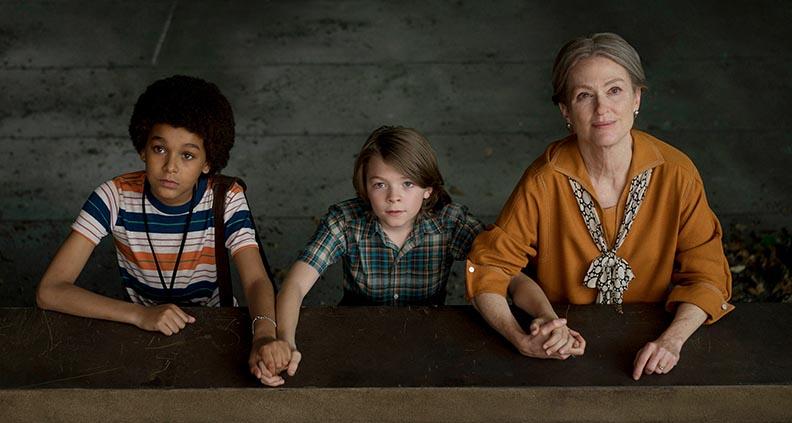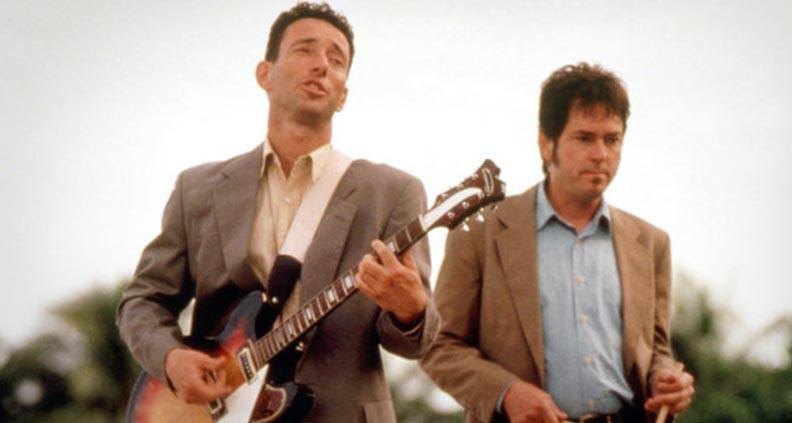Know the Score: Film, from Silence to Sound
Each month in Know the Score, writer and composer Aaron Gilmartin will step out of the scoring stage and explore, in detail, some important aspect of movie music. After all, film is as much about what you hear as what you can see.
***
One way to look at the elements that make up a film’s sound is this simple, three-part breakdown: 1) dialogue and ambient location sound, 2) dialogue and ambient location sound, accompanied by music; or 3) dialogue and ambient location sound accompanied by a recognizable song, or “needle drop” as it’s sometimes called. We can break each of these categories down even further—but, generally speaking, these are three options we have to choose from as we decide how our film will sound from scene to scene.
Some of the most effective film scores are full of moments or entire sequences suffused with loud, powerful music. For these full orchestras—and often, electronic instruments such as synthesizers—are brought to bear in support of the onscreen action. But equally effective scores can also be very quiet, employing very little music, or no music at all. Films benefit from musical support as much as they do from silence, and a powerful emotional moment can be equally improved with music or with silence.
Nor are all moments of silence the same. Absolute silence does not exist in nature. There’s almost always a background hum from the wind or a tiny fan whirring inside an electronic device. Therefore, absolute silence would be as false as any other contrived element within a film. And in creating the small ambient sounds that make an aural environment feel realistic the thoughtful use of silence is critical.
Silence gives the entrance of music and sound design all of its power and substance. If the music and sound effects were played constantly, we’d lose that moment of contrast and transition—from silence to sound—that creates such a dramatic effect. Music can enter boldly to great effect. Or it can be just as significant sliding in softly and unnoticed.
Here are some tips for how filmmakers and composers can work together to effectively harness the sounds of silence for great dramatic effect…
QUIET MOVIES
Films without music are rare, perhaps because we can all imagine how mounting tension might be enhanced by musical accompaniment.
In Alfred Hitchcock’s Rope (1948) the audience witnesses the drama in sterile silence. One killer begins to worry but the other revels in their accomplishment, and the tension between them rises. There is no music to save the audience from the airless witnessing of their struggle. Silence is key to the effect this film produces.
In Sidney Lumet’s Dog Day Afternoon (1975) the action is again left naked of music; the tension of the conversation between the authorities and the raving protagonist rings out starkly, without any interruption. Tension rises without music to calm, distract or even remind audiences of the fact that they’re watching a movie. And for a film like Dog Day Afternoon meant to evoke documentary-style realism it’s the correct choice.
MOVIES WITH MORE MUSIC

Iconic films with great scores often use a lot of music. By “a lot” we mean that over half the run time of the film is supported by musical score. A film like Steven Spielberg’s E.T. the Extra Terrestrial (1982)—with its emotional main theme—wouldn’t be as impactful without its musical score. As an example we can watch, E.T.’s famous escape on flying bicycles without and with music. Here the scene without score:
And here it is, with John William’s original score, in tact:
Of its 115 minutes of run time, E.T. has 80 minutes of score. Some of it is very gently presented in low volume and some of it is soaring as with the flying bicycles above. The music really helps us feel how uplifting the moment is—perfect for a fantasy film meant to instill feelings of wonder and awe in its audience.
Long musical scores that accompany a majority of a film’s running time go back to the very early years of sound film in Hollywood. And we continue to use these sorts of “long” scores today—just check out any franchise mega-blockbuster or CGI kids’ movie.
Carter Burwell points out that he wrote 80 minutes of music for director Todd Haynes’ 2017 film Wonderstruck, in support the film’s wide-ranging story. The plot goes many different places and is set in multiple eras. For Burwell this meant that the development of the characters and their travels required more cues and a longer score.
MOVIES WITH MORE THAN A SCORE

When a song takes the place of score, it introduces the possibility of new dynamic changes and even serves as shorthand for an emotional connection, based on viewers’ prior experience(s) of the song. Often entering with a substantial volume, a needle drop can change and direct the interpretation of a scene as much—or even more—than an orchestral arrangement. Familiar songs can provide a welcome moment of recognition.
The lyrics or feeling of a song can be also jarring if they do not mirror the action, a juxtaposition that can be used to great effect. A scene from Quentin Tarantino’s 1992 debut Reservoir Dogs uses the Steelers Wheel song “Stuck In The Middle” in this way, with onscreen violence contrasted with the lighthearted feeling of the music:
Whether a song is familiar to the listener or not, it can nonetheless become inextricably linked to the film and its moments. This can add another level of intensity for the musical accompaniment.
An interesting recent take on this is in the 2018 Coen Bros. release The Ballad of Buster Scruggs. The filmmakers’ use of the familiar melody previously known as “Streets Of Laredo,” but called by it’s older title “The Unfortunate Lad.” The film—and especially this stagecoach scene—gains weight and emotional connection with the familiar melody:
But the lyrics are unfamiliar and sadder than the more familiar version, adding a new depth and eerie emotion to the scene. There are myriad instances of songs that help a scene along. Music in film has a wonderful power that is made even more effective when combined with a good amount of silence for contrast.
To sum things up, there are many moments in film where silence is the only good choice. In these cases, the drama is best served by the background sound of the scene with no additional music; music would be a distraction from the onscreen action. A third option is the introduction of song. Where a song is used, the singing voice can add a new level of emotional connection—especially when a song is already widely known or the vocal performance is especially powerful.
Silence or orchestra or synth or song they each come with their attending strengths and all can powerfully support a moment in a story.
To learn more about Aaron Gilmartin, visit his website. Become a Member of Film Independent by visiting our website, and click here to subscribe to our YouTube channel. And why not be our friend on Facebook, Twitter and Instagram?
